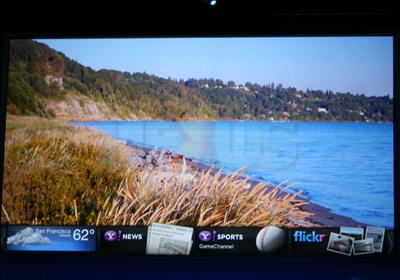Everyone loves television, right? Intel's Eric 'gameshow host' Kim think so.
The question, we suppose, is how PC-centric companies can break into the consumer electronics market? Intel tried and failed with Viiv, and AMD, et al, have all had a go but not cracked the TV nut - trying to make far more interactive.
Bringing the Internet to the TV has been fraught with problems in the past, then. Attempting to meld the two together, Intel and Yahoo announced the Widget, using, well, the Yahoo Widget Engine.
Using a CE-optimised SoC (system on a chip) - Intel Media Processor CE 3100 - endowed with the (x86) IA architecture and running alongside a high-definition TV, through Linux, Yahoo's Patrick Barry demonstrated visual plug-ins - widgets - that allowed one to access online content via an easy-to-use GUI.
The snippet bar, at the bottom, lets you choose with online content to access, and additional plug-ins can be used to expand content - downloading films and online shopping, from example.
It's a pretty cool interface, allowing either full-screen Internet browsing or the main picture, shown above.
Canmore SoC
Coming back to the CE-optimised SoC, formerly known as Canmore, it's a new package that re-uses some older technology.
A look at the block diagram shows it to be based on Intel Pentium M processor running at 800MHz. The 'system' interfaces with regular DDR2.
Using the chip's basic 3D rendering ability, casual gaming is possible, alluded Kim. He further commented that the chip employs a complex multi-format decoder that can handle the usual codecs - H.264, VC-1, and MPEG2. Further, the entire chip consumes around 10W when under load, allowing for passive cooling.
Future iterations of this SoC will use the energy-efficient Atom (Silverthorne) core as a base, we were told.
Put simply, Canmore is a repackaged array of Intel technologies that serve as the technological base for, shall we say, TV+. The real win is the content, of course.















